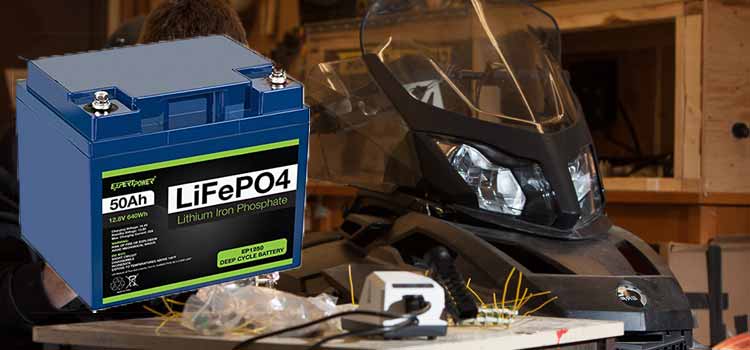
Snowmobiles are fun and all, but a dead battery in a snowmobile can really be a drag. Just like you, I have dealt with enough dead snowmobile batteries to know the frustration of using pull start in freezing-cold, or trying to boost power just to get started up and back home.
I have thoroughly tested a number of batteries over the years to find the best battery for my snowmobile, and I’ll share it with you here today. I have given not one but four battery recommendations for your snowmobile, so no matter how tight or loose your budget is, you are going to find the perfect battery for your snowmobile that is guaranteed to last.
Among all the batteries that I have tested, the EarthX ETZ14C lithium-iron battery outperformed the competition. It performs consistently throughout its life and does not get affected by cold weather where other batteries struggle sometimes.
Best for all: Weize YTX14 BS
Great power and reliability at a very affordable price.
This battery performs great for starting a small to medium size snowmobile with 660cc engine size. It holds charge for long, and has decent power for hand warmers, headlights and other third-party accessories. All that for a price of less than $50.
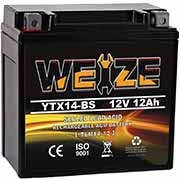
I never thought that any battery that costs less than $50, will last more than one season in a snowmobile until I found this battery. The ‘YTX14-BS’ is perfect for a replacement battery for a snowmobile. It is 5.9 inches long, 3.42 inches wide, and 5.7 inches in height. It can easily fit inside most battery boxes of snowmobiles.
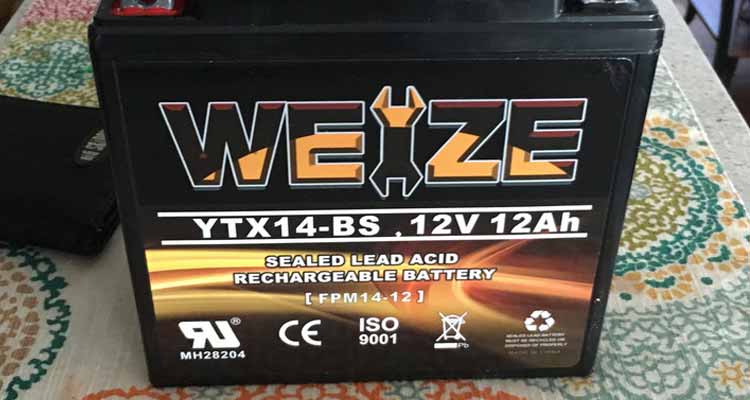
Power
On paper, this battery claims 230 cold-cranking amps that are sufficient to start a medium-sized snowmobile with a 600cc gasoline engine. But you are not here for the specs, are you? In my testing, this battery performed well and delivered 190 cold-cranking amps without breaking a sweat when starting the snowmobile.
This battery also provides enough power for aftermarket headlights and other accessories like heated seats and hand warmers. I have noticed that after installing this battery in my snowmobile, my hand warmers work-perfectly and provide constant heating.
Terminals
The terminals of the battery are sturdy and use nut and bolt terminals to connect to your snowmobile. Most snowmobiles already use these nut and bolt wire terminals for the battery connectors. But if your snowmobile is older, then you will need to change the wire terminals with the nut and bolt ones to connect this battery.

Maintenance
This battery is maintenance-free, which means you do not need to fill the electrolyte, unlike regular lead-acid batteries. It comes pre-charged to roughly 12 volts, so you only need to install it and crank the engine. You do not need to plug the battery into the charger and wait for it to finish the charge.
Terminal corrosion is a different story. Terminals on my battery did not corrode even after two years of use. But I take good care of my snowmobile and clean dirt and salt deposits from under the hood regularly. I have seen some people complain about the battery terminals getting corroded on this battery, and I suspect this corrosion has to do with dirt and salts and not with the battery itself.
My thoughts
I have been using this battery for one and a half years in my snowmobile and about 7ish months in my bike. And it is still going strong. Of course, it has lost some of its performance, but still, it works and starts my snowmobile without a problem. I can blindly recommend this battery to anyone with a small to medium-sized snowmobile because it is inexpensive, and it just works.
Weize is a known brand, which makes high-quality batteries for power sport engines. But, sometimes, you might find yourself in 5% of people that are unlucky and get a defective battery. Fortunately, customer service is good, and you can easily get your battery replaced in a week. This battery also comes with a one-year warranty, so if you still have any problems down the road, you can easily get a replacement battery again.
Upgraded Pick: EarthX ETZ14C Lithium Iron Phosphate Battery
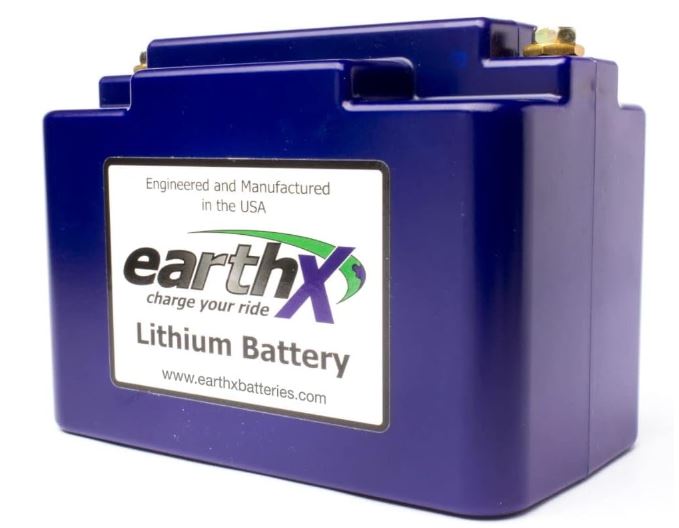
This battery is expensive, but in my expert opinion, it is worth buying. The technology and the chemistry of this battery are completely different from an SLA battery. I have written a blog post on why lithium-iron batteries are good for snowmobiles. You can get a good amount of information about lithium-ion batteries and their performance in snowmobiles.
The EarthX battery was created specifically for the cold weather snowmobile market with a battery management system that has been modified for cold start temperatures. It is a compact size so it will fit ANY new snowmobile, whether it is a Polaris, Ski Doo, Yamaha, Arctic Cat, BRP. It has amazing cranking amps of 330CCA and weighs in at only 2.5 pounds, compared to 15-20 pounds for lead acid batteries.
EarthX ETZ series of starter batteries are the most innovative and technologically advanced batteries on the market, with an exclusive fully integrated battery management system for premium performance and better longevity. In addition to its high cranking ability, the battery features overcharge protection, cell balancing technology, short circuit protection, 1 year FULL COVERAGE WARRANTY and easy installation. This battery is designed, engineered and assembled in the USA.
Power
This battery is designed to work in a wide range of temperatures and especially in cold climates. In my testing, it delivers about 327 CCA in -20 degrees Fahrenheit. It can easily start any snowmobile from small to large engines. The smooth sound of the starter motor tells how powerful the battery is. I rarely need to give a second push to start my motor.
The discharge rate is slow and constant that makes it more efficient and powerful. I have checked using a multimeter, and it gives 12+ volts even when the battery is weak.
The reason behind the long life of this battery is its built-in battery management system (BMS). It controls the charging and discharging of the battery and protects the cells inside the battery from overcharge, short circuit, deep discharge, and overload.
Terminals
This battery has high quality terminals that never corrode because it does not emit any acidic fumes.
The terminals are rigid and the most easy to connect I have found. It only needs a bolt to be screwed, not like regular battery terminals that requires a nut and bolt.
Maintenance
This battery is maintenance-free, and once installed, you do not need to connect a trickle charger (or any battery maintainer) with it. This makes it completely eco-friendly and hassle free.
This is the second season the battery is working fine without any hesitation. It is smooth and powerful at startup. Usually, after summer, most snowmobile batteries become weak and last maybe a month or two. This one still works like new.
How long with this EarthX LiFePO4 battery last? They claim it will go 2-3x longer than lead acid batteries, meaning it’s possible that I’ll still be using this battery after 10 years. Seems a little too good to be true, but time will tell.
Many batteries have warranties, but they are often prorated and require fees and difficulty with returns. This battery comes with a 1 year 100% replacement warranty, which is tough to beat, and highlights the confidence EarthX has in the quality of their product.
My thoughts
For me, this battery has the best performance of all the batteries I have bought or tested. It is expensive, but at the same time, its reliability and efficiency are worth spending that much money on. Not only the power, but this battery also lasts longer than SLA batteries. If you think of it as an investment, the high price is certainly justified.
Budget Pick: Yuasa YTX20HL-BS
Reliable and a powerful battery for less than $50.
This battery costs less than $50, and the performance is still better than many expensive batteries. This battery is reliable and powerful. It can last for two to three seasons if properly maintained. So, this is a perfect bang for the buck.
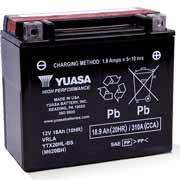
You might have heard about the ‘YUASA’ because it is very famous for car batteries. I found this model in a friend’s garage, and I borrowed it to test it. As the battery claims, it delivers 310 CCA that is enough to start any medium to big sized snowmobile. But I wanted to test this battery in -15 to -20 degrees Fahrenheit, where most of the batteries fail.
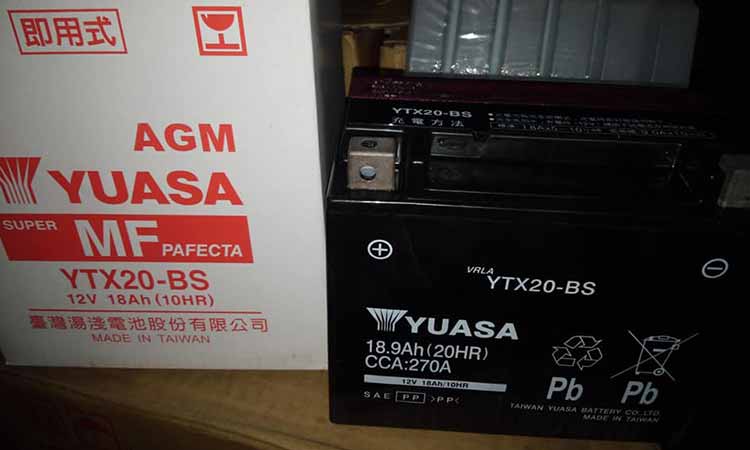
Power
I had to wait about a week for the temperature to drop down to -20 degrees Fahrenheit. In extreme cold, it cranked up my rush 600’s engine smoothly. I turned on the electrical system, the headlight, the hand warmers and went for a ride. Everything was working well, and I am satisfied with its performance. In my testing, it delivers about 280 to 290 CCA that is amazing for a battery for less than $50.
Terminals
The terminals are hard and durable. The nuts and bolts that come with the battery are small, and I prefer to use aftermarket nut-bolts to connect the wire lugs. I read the description of this battery on Amazon that says that it is sealed and made from advanced lead-calcium technology. So it must not emit any fumes. But it is not true as the cells of the battery have caps, from where the electrolyte is filled.
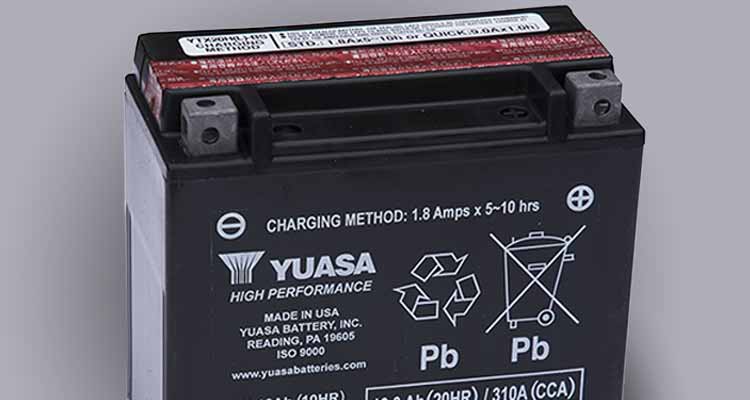
I did not see any corrosion on the terminals in my testing. But you might face an issue after 8 to 10 months.
Maintenance
Coming towards maintenance, it needs the electrolyte to be refilled, and after a month of use, you must check it regularly to increase the lifespan of the battery. Not only this, if the battery is not in use you will need to connect a battery maintainer or a trickle charger, otherwise, it will lose the charge after a week. If it starts losing current, it will die very soon like any other battery. Is all that hustle worth the battery?
Yes, it needs maintenance, but it rewards you with reliable and seamless performance. After a year of use, this battery is working like new without compromising the performance. As compared to many AGM batteries, it performs very well, even in extremely cold climates.
My thoughts
There is a rare chance that you get a defective piece, but do not worry because Yuasa has one of the best customer support and fastest shipping service. They will replace the battery for you.
There is a one year warranty for the battery. But if the proper maintenance is done, it will work for about 1 to 1.5 years. After the first year of use, you will notice a performance drop, but that is not that significant to make you start looking for another battery.
A good second option: Power Sonic PTX14-BS
Packs enough power for a medium size snowmobile within a budget.
Power-Sonic might not be a famous brand, but they take their quality assurance to a whole new level by getting certified from ISO. This battery has ISO 9001 and ISO 14001 quality assurance certificates. But do these certificates mean “quality” in real-world testing? Let’s find out.
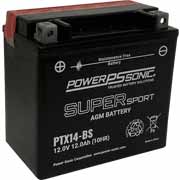
Yuasa fits a wide range of small to medium-sized snowmobiles. In my testing, I have found out that it can also fit in some large-size snowmobiles. It completely depends on the dimensions of the battery box.
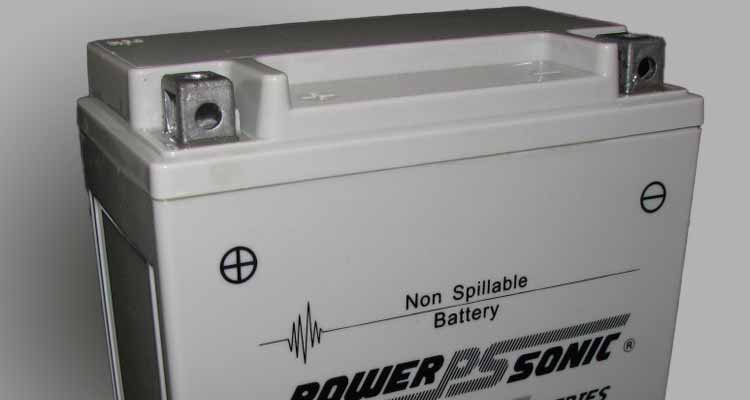
Power
This battery packs a lot of power, and when comparing this with YTX14-BS from Yuasa, it performs about the same, with Yuasa performing a little better in some situations. These results can vary from snowmobile to snowmobile, and most of the time are not even noticeable.
This battery provides 12 AH, which is sufficient to start small to medium size snowmobiles. At 0 degrees Fahrenheit, it gives about 167 CCA, and it can easily crank up a 600cc engine.
All the electrical system works fine and without any compromise on performance. I have an after-market headlight, and that works great with this battery. The hand warmers and the heated seat works fine too.
Terminals
The terminals have a rigid build quality and do not feel like they are going to break anytime soon. The wire lugs are simply screwed on the battery terminals either on the front or on the side. It depends on the length of the wire or/and battery box in your snowmobile. The nuts and bolts are included with the battery. You can use a simple screw wrench to tighten the wire lugs on the battery.
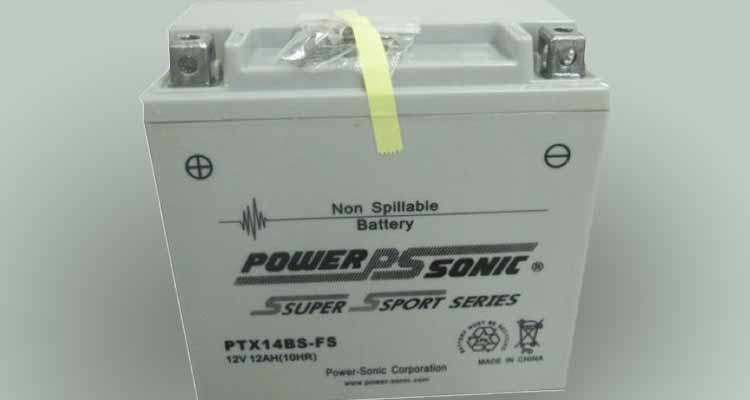
Maintenance
The battery comes dry with acid/electrolyte in a separate bottle. You have to peel off the red tape on top of the battery and fill it with the acid/electrolyte. After filling, make sure that you have capped the cells tightly. It is a one time process that must be done properly, so the acid does not spill out of the cells. After that, you do not need to worry about filling the electrolyte, ever.
When you are not using the battery, like in summers, you will need to connect a trickle charger with it. Without it, this battery is not going to last more than 6 to 8 months. So, for me, this battery needs some maintenance, and it is not completely maintenance-free.
My thoughts
After using this battery, I can say that it is a good option for a small to medium-size snowmobile. Although this battery can crank up a 600cc engine, that is going to put a strain on the battery and the terminals, which they are not designed for. It poses a safety hazard not only with the battery but also with your snowmobile.
The battery lasted for about 7 to 8 months for me, and it is because I forgot to connect the battery with a trickle charger. I took this battery to the store from where I bought it, to know why this battery died very soon.
The technical guy there told me that it needs a trickle charger when not in use. So, by using a trickle charger when the battery is not in use, I am sure you can make it to about 14 months.
How I tested these batteries to find the “perfect” one?
Testing batteries (and a lot of them) is hard. I spent over two months (in my garage and out in the snow) testing these batteries for snowmobiles to ensure that my recommendation for the best battery for a snowmobile, truly is the best and worth spending money on.
I first Googled about what batteries are the best for snowmobiles to see what other snowmobilers recommend. I also visited my local power-sports shop, to see what they recommend as the best battery for a snowmobile.
So, I began buying batteries for my testing. But that testing could not have been completed without my friends, who were happy to test these batteries out with me.
Charging the batteries
Although batteries that I bought from my local power-sports shop came pre-charged, I still needed to charge the ones I bought off Amazon. It gave me a better chance to fully use (and also test) my Noco Genius 5 battery charger. The charger performs well and, it charged the batteries to around 13.0 to 13.5 volts (which is what a fully charged lead-acid battery should readout). Here, I found out that Weize YTX14-BS gives 12.8 volts, and the EarthX lithium iron battery gives 13.5 volts when fully charged.
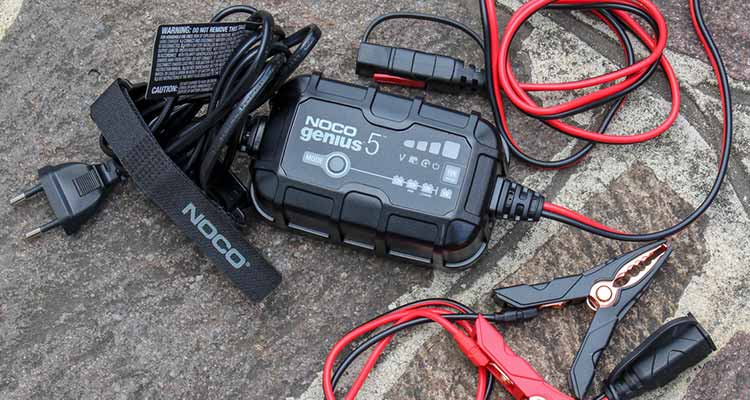
Charging these batteries to a full 100% made each battery perform its best. It allowed me to conclude fair results for each brand of battery.
Installing the batteries in snowmobiles
I would again like to thank all of my friends and family members who helped me testing these batteries in their snowmobile.
I begin installing the batteries, only to find out that some batteries are either too large or too small for the battery boxes of different snowmobiles. It is not the problem with batteries, but with snowmobiles and power-sports in general. Unfortunately, there is no standard size for batteries in power-sports.
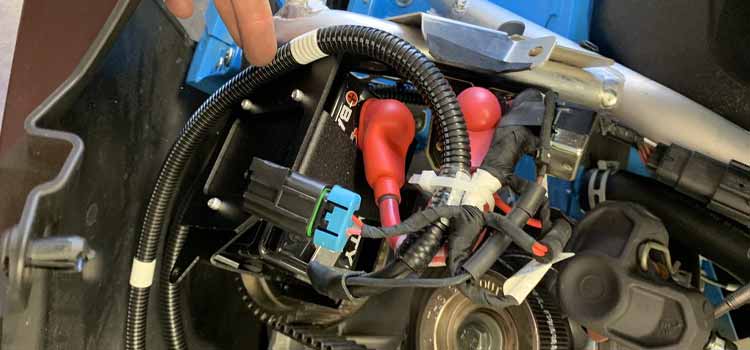
Later, I found out that connecting the wire lugs to the battery terminals is a little challenging. The connectors were all different depending on manufacturers. The terminals on the EarthX lithium iron batteries are the most simple and secure ones that are very easy to use.
Cranking the snowmobiles
I performed my testing in the cold mornings of Wisconsin. Starting a cold engine is a hard job for any battery to handle. But in temperatures below zero degrees is much hard. As expected, it took several spins of the starter motor to start the snowmobiles, but they all started. During my testing, I found out that EarthX lithium iron battery performed much better and started the snowmobile on the third push. On the other hand, Yuasa took four to five tries, and the lithium iron battery took two to three attempts. Power Sonic’s PTX14-BS took the most attempts: three to six in my testing. For a fair game, I picked 12-14Ah batteries for small to medium-sized snowmobiles. And 18 to 20Ah batteries for my Rush 600 and my brother’s Rush 800.
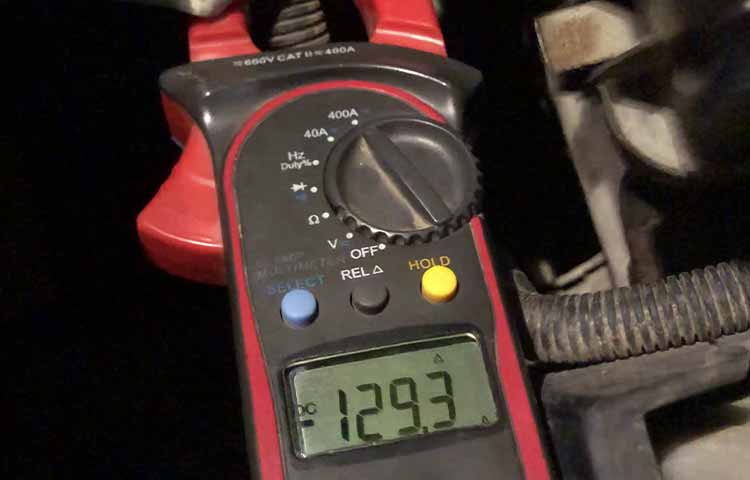
Testing these batteries myself gave me some interesting results and uncovered the marketing-lies, that manufacturers tell us to sell their products. I have found out that peak amps and cranking amps are just a number that you should avoid looking at when buying a battery. During my testing, I have found out that most batteries performed differently from what the manufacturer claimed. EarthX was the only brand that performed close to what the manufacturer has claimed.
I used a clamp meter to measure the amps that each battery delivered at each start and a multimeter to see what voltage the battery dropped down to before finally starting the snowmobile. Further, I logged these readings into a spreadsheet and exported this graph so you can see which battery took the most cranks to start a cold snowmobile.

I took measurements after every week for about a month, so that if the battery is good it will give consistent performance. These readings make me shorten my list of batteries. After all this testing, now I have a list of 4 batteries that I can recommend to anyone and seven others that come with a compromise.
Durability
Unlike a car battery, a snowmobile’s battery is going to get shaken around when you are going to be drifting and making tight turns to make snow fly on your fellow snowmobilers. Sometimes, this can result in terminals breaking off. Also, the extreme cold poses the risk of cracks in the plastic of the battery. I tested for this same thing, and the results are close to what I was expecting.
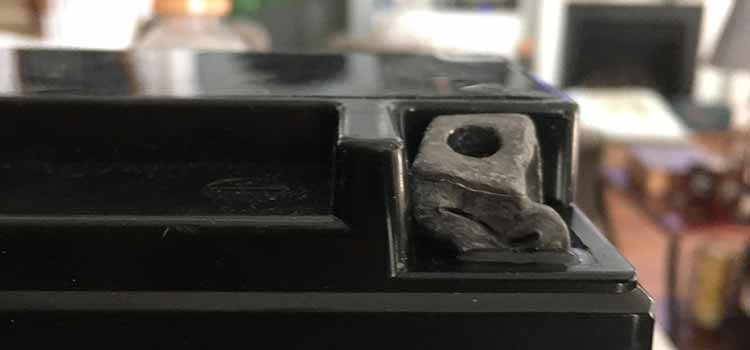
After two months of testing, only one battery broke with a crack on the bottom side. It caused the electrolyte to leak out, which caused rust and oxidization of the battery box.
Terminals are a whole another story. Some batteries had large and sturdy looking terminals, and some had small terminal posts. I tested them with my usual pulling-with-hand-to-see-if-they-are-loose thing. I found out that the dimensions and design of the battery box plays an important role in durability terminals. If your terminals touch the battery box, they might break. Ideally, the battery should fit inside the battery box, and if the battery box has a lid, the terminals should be an inch away from it.
I also found out that some cheap batteries had big terminals that might look sturdy but were not made out of pure copper. This not only made them heat up when under load, but also melt down the plastic of the battery. Which posed a risk of a potential fire. These batteries are a no-no for me, and I have excluded them from my recommendations.
Battery heating
You might be wondering, that why a heating battery should be an issue in snowmobiles? And the battery is not even going to get warm in such low temps… Wait. There is more to the heating of a battery. Batteries might not feel warm to touch. But the internal cells of the battery might heat up so much, that the electrolyte starts boiling. It happens when manufacturers use low-quality materials with impurities in their batteries.
During my testing, I tried to measure this with my Fluke 87V (with a thermocouple), but I was not able to get a reading. Unfortunately, this can not be measured easily, and there is nothing that you can do about it. The best is to skip the shady-manufacturers and avoid battery brands that no one had ever heard of.
Batteries that are not worth spending money on
Below are the seven batteries that failed my test in the aspects of durability, power, and price. I do not recommend buying these batteries for a snowmobile. Many of these are great in other features, but not best for a snowmobile. I have reviewed them so you can know what I did not like about them.
Pirate Battery YTX20L-BS – Link to Amazon
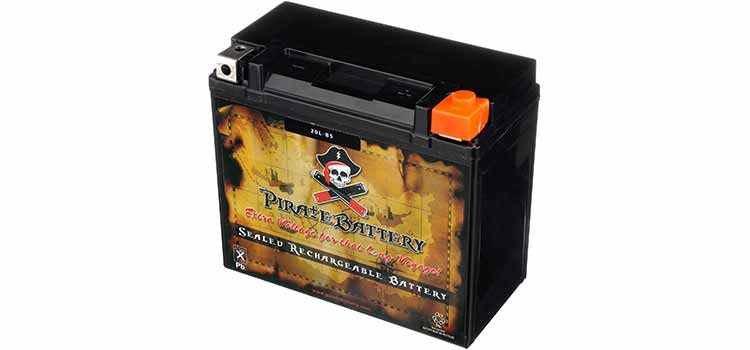
I found this battery for under $55, and it performed great when it was new. But that’s what every battery does at the beginning. Pirate Battery says that it gives 270 CCA. After two months, this battery started to struggle while cranking up the engine of my Polaris Rush 600. So, again I would advise you not to go with the numbers only.
The terminals are firm and rigid. The wire lugs are connected to the terminals using nuts and bolts. But they were not included in the box that I received.
I was disappointed by the build quality of the battery. It is made up of cheap plastic. Anyway, what I found interesting was that you can not let this battery sit for two more than ten days. It will be dead as a cow, and you will need to charge it again. It tells how long that the battery will last.
This battery lasts about a year, and you can not do anything else to prolong that lifespan. It also needs a trickle charger for when the battery is not in use. Otherwise, it will hardly last about 7 to 8 months. There are other better options at this price, and I have mentioned them above.
FirePower HJTX20HQ-FP – Link to Amazon

This is a lithium-ion battery. Many people, including some of my friends, disagree with me on the use of lithium-ion batteries in snowmobiles. I say that lithium-ion batteries are not the best for power sports. There was a time when I used to believe the same, then my brother (who is a high school teacher) taught me about the difference between lithium-ion and lithium-iron batteries.
Lithium-ion batteries need constant current for charging. That is not possible directly in a vehicle with a combustion engine. The same is in the snowmobiles. The alternator generates the current that varies up the rotation of the stator along with the engine. So a lithium-ion battery will die very soon. That is why lithium-iron batteries are recommended (and best) for snowmobiles (or other vehicles). They last much longer than lithium-ion or SLA batteries.
This battery is powerful, and it can crank up any snowmobile’s engine without a problem. Even the electrical system is not a problem for it. It is almost three times the price of a standard SLA battery. Using it on a snowmobile is not a good option as it will not last as long as it should. It is not a bad option at all. The only problem is that it is not designed for power sports or gasoline vehicles in general.
The terminals are sturdy and come with nuts and bolts that are needed to connect the wire lugs. The built quality is good, and I am satisfied with that.
So, if you are willing to spend that much on a snowmobile’s battery, then go for ExpertPower. If you want to learn more about lithium-iron batteries, you can read this blog post where I have discussed every bit in detail.
Energizer TX20HL – Link to Amazon
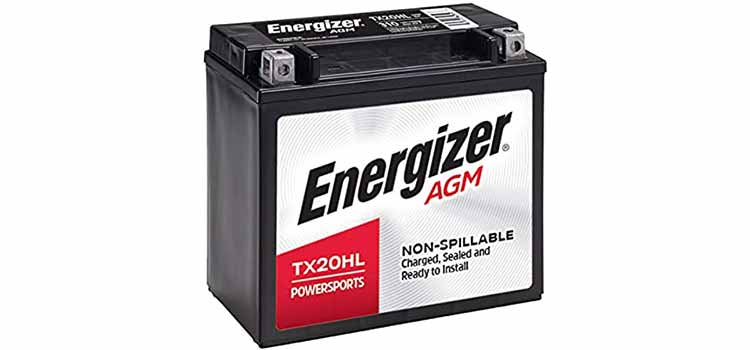
Energizer is a big brand in batteries that do not need any introduction. This battery might look like a good option for a snowmobile. But I think there are better options in half the price of it.
It is powerful and can crank up any snowmobile engine. But it starts to struggle while cranking up the engine when the temperature drops below 5 degrees Fahrenheit. It can easily handle all the hand warmers and the heated seat.
The terminals are not sturdy and can even break during shipping. I got this battery with a broken terminal. I found out that I was not the only one after reading other reviews of this battery on amazon. So, this is not acceptable for me if I am paying more than $100. Where on the other hand, I can get a better one for under $60.
It is just like a regular SLA battery with a hyped-up price tag. I would rather go with Yuasa or Weize than this one.
Zipp Battery YTX20L – Link to Amazon
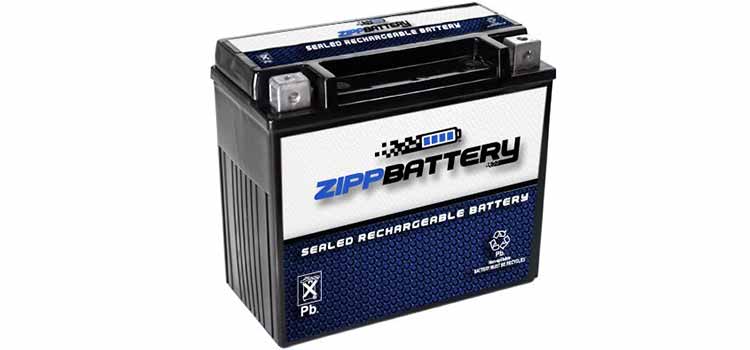
This is a power sport battery that does not bear the environment of a power sports vehicle. Like in snowmobiles, this battery struggles to crank up the engine in extreme cold. Even the hand warmers and the heated seat performs average on this battery.
This battery is not what I would recommend for a snowmobile. It has enough power to crank up an 800 cc snowmobile, but that power fades away when the temperature drops.
The terminals are sturdy and require nuts and bolts for connection. Even the build quality is strong and durable.
It is just like any other SLA battery. It also requires a trickle charger when it is not in use. With all that maintenance, this battery will last about eight months.
As a snowmobiler, I need a battery that can operate under low temperatures. So, this is surely not an option. I would rather spend a few more bucks and make my snowmobile reliable for long routes and vacations.
Mighty Max YTX20L-BS – Link to Amazon
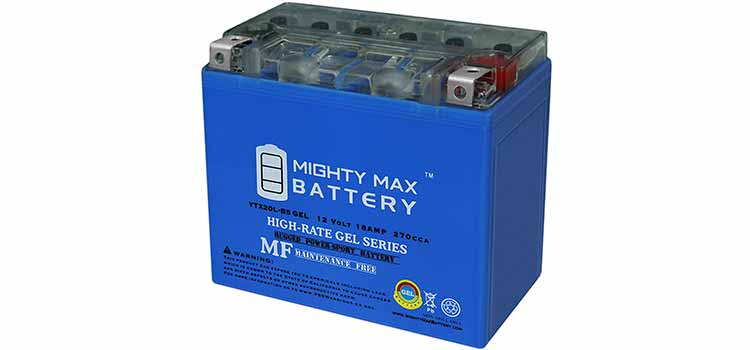
This battery by Mighty Max is a good option for power sports, except snowmobiles. I can say this based on my experience with this battery.
The terminals are firm and sturdy. But the terminals are inverted, the positive terminal is on the left, and the negative one is on the right. If the wires are small, you will need to extend them.
Like any other SLA battery, it also requires some maintenance when it is not in use. It requires a trickle charger that you must connect to prevent the battery from dying.
In my experience, the battery was good for about a month. After that, it started to struggle when cranking up the engine. Overall it performs its best for about a month. That is why I do not recommend it for snowmobiles.
This battery gives peak performance for about a month. After that, the performance of the battery will start to decrease. About two months later, this battery will struggle to crank up the engine. So, if you are going to buy this battery, you better make sure your sled has a working pull-start too.
ACDelco ATX16BS1 – Link to Amazon
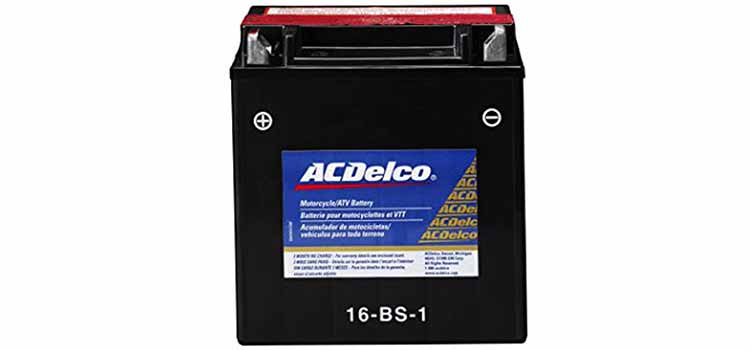
Usually, AGM batteries come with a pre-filled electrolyte. But this one requires to be filled with the electrolyte before installing it. There is tape on the top of the battery. You need to peel that off and fill the electrolyte in the cells. The electrolyte comes along with the battery.
The method is related to Yuasa, but the results are far different. And it costs about $100 (almost twice the price of Yuasa).
It is a powerful battery that can be installed on any snowmobile. You can ride with all the electrical systems turned on with this battery. Butt, all that comfort is for about seven months. After that, you might face some problems.
The terminals require nuts and bolts to connect wire lugs. But in this battery, the direction of nuts and bolts is sideways. If you have very little space in the battery box, that will be an issue. The nuts and bolts come in the package. So, confirm the dimensions and space before buying it.
When you are not using this battery for more than a week, you must connect the trickle charger. It will let the battery last a little longer. Overall with maintenance, it will last for about a season. At this price, it is not a good option.
Chrome Battery YTX14-BS – Link to Amazon
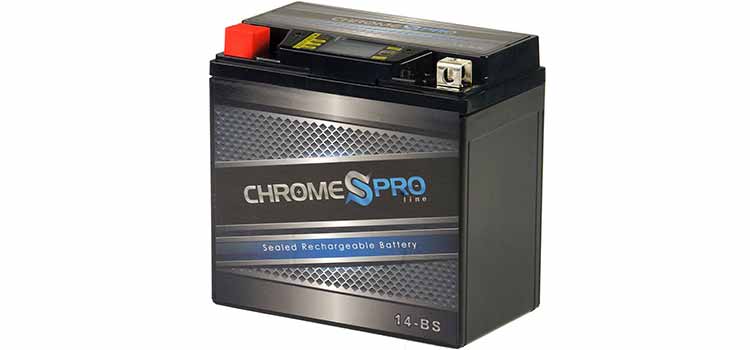
Although this battery is notorious and performs above average in power sports, it still has some flaws that make me not recommend this. This battery is powerful enough to handle a small to medium size snowmobile with its 12 Ah capacity.
There is a small LCD screen on the battery between the two terminals. This screen shows the battery level and the battery voltage. It is a useful feature, but it is not too convenient as I have to lift the hood and reach the battery every time to check if the battery is low.
The only problem with the terminals is that they will meltdown if you keep using the battery under high load. That means you are restricted to keep the load under 6-8 Amps. It limits you to use this battery only in small size snowmobiles. It is something that not only me, but no one will ever consider this battery.
When I was testing the battery, the terminals melted after a week of use. So, I could not confirm how long the battery will last.
Here are 5 Things to look for when buying a snowmobile battery
After performing all this testing on different batteries and different snowmobiles, I have made a checklist that you can follow to find the best battery for your snowmobile.
Battery box size and design
The first thing you should look for is the size of the battery box that your snowmobile has. You have to make sure that the new battery is going to fit inside your snowmobile. There are two ways you can see what size battery box you have: Measure the battery box of the snowmobile from inside or measure the old battery itself. I do not recommend you looking in the user/service manual for the battery box size. It is because the battery compartment size may vary due to different versions and changes.
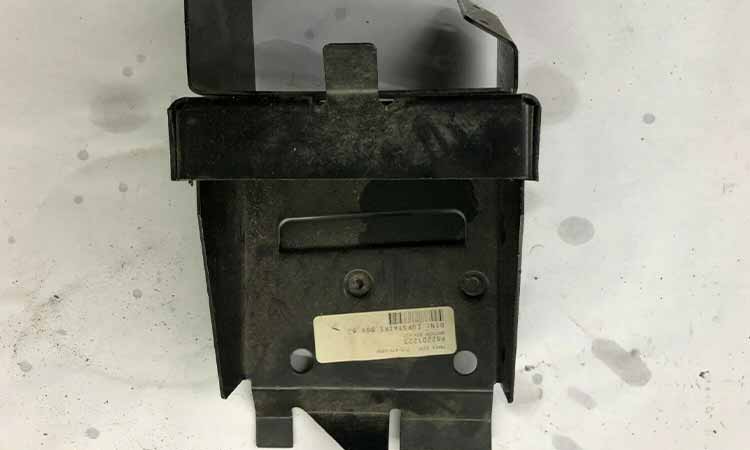
After measuring the battery size, you also have to check if the terminals of the battery are going to easily fit inside the battery box without hitting or touching anything. If your battery box is too small, then the terminals might touch the metal and short the battery out.
Also, check for terminals and what type of terminal connectors are already installed on the battery wires. If you are going to buy a battery with different terminals than the old ones. Then you will need to change the terminal connectors on the wires too, to match your new battery.
You can also replace the battery box in your snowmobile. Depending on how comfortable you are working with your snowmobile or if the battery box is bolted, riveted, or welded to the frame.
You might even need to extend the battery wires if they are too short for your new battery. This must be done properly. Make sure the wires are connected securely and properly insulated from each other and other metal parts of your snowmobile.
Power
My advice: Do not always trust manufacturers or what the label on the battery says. I have seen batteries that promise to deliver a bank but can not even start a 250cc engine.

Mostly the advertised CA (Cranking Amps) are not always real, and sometimes manufacturers put peak Amps, which is just a false number. The maximum current that a battery can deliver as an initial burst while cranking the engine, refers to peak amps. On the other hand, CA or CCA (Cold Cranking Amps) is an industrial rating that tells about how many amps a battery can deliver at 0 degrees Fahrenheit for at least 30 seconds. It depends upon many factors: the temperature, age, and current charge level that the battery is at. But most importantly, on the size of the engine. So in short, the numbers are never always correct.
If you want to test out the maximum power of the battery, you will need a clamp meter. Then put a heavy load on the battery. I have seen some auto mechanics short out the two terminals of the battery, and measure the amps transferring through the cable. It is not safe at all. DO NOT DO THIS.
If you are going for an aftermarket battery, you must check the capacity (Ah) of your stock battery. Then look for a battery that has the same capacity or more. If your stock battery has 19AH capacity, you must buy a battery that can deliver 19 AH. There are different models in each battery that are differentiated based on their capacity. For example, Yuasa YTX20HL has 19 AH capacity, and Yuasa YTX14l has 12.6AH capacity.
Durability
Power-sports batteries are generally more durable than regular car batteries. But, if you only buy from trusted stores or trusted brands. These batteries are-designed to bear harsh weather and shocks that usually come with power-sport vehicles. If the battery is made out of cheap plastic, it can crack and fall apart due to extremely cold weather. It will not only damage the snowmobile (from leaked electrolyte), it can also pose a risk of fire and explosion.

Terminals of the battery are as important as any other thing about the battery. Terminals of the batteries are very hard to repair. So, if the terminals break, then you can not use the battery. Some cheap batteries have poor-quality terminals that have impurities in them. When you crank the engine, a large amount of current flows through them. It might cause the terminals to become hot and even melt the plastic, or even spark internally.
Terminals should also bear corrosion and should not fall apart from regular oxidization and acid deposits that appear after regular use.
Maintenance
Batteries are consumable products, which means you need to take good care of them to get the maximum life out of them. Like your phone, if you do not charge it properly, the battery is going to become weak and lose its power sooner. If you are looking for a compatible charger or a battery maintainer, read my article on the best snowmobile battery chargers.
In the end
After years of snowmobiling, I have to know that not every battery is going to work in a snowmobile. For example: if a battery works good for a motorcycle, it probably is not going to work in a snowmobile, or at least for more than a season.
If your budget is around $50, then WEIZE YTX-14BS is the best choice for snowmobiles. I have seen this battery on sale at Amazon for less than $50 (even sometimes $30). This makes it an excellent choice for snowmobiling. Pair this with a good trickle charger, and you have got yourself covered for at least two to three years.
If you are willing to spend a little more than YUASA YTX-20 HL is a great option. It has enough power for medium to large-size snowmobiles, and you can often find it on sale at Amazon for under $80. If the price is more than $80, then I would suggest you go for WEIZE. It is not worth spending an extra $50 over WEIZE.
And, If you want the best battery, then EarthX has got you covered. It is a far newer technology. It requires zero maintenance, to keep it going for like 5 to 6 years easily. Sure, it costs much more than a regular SLA battery, but it also lasts a lot longer than an SLA battery, which justifies its price. Plus, you do not have to worry about refilling the electrolyte or removing corrosion from terminals.
So,
What do you prefer? Investing more for once or keep sticking with a maintenance routine of the battery?